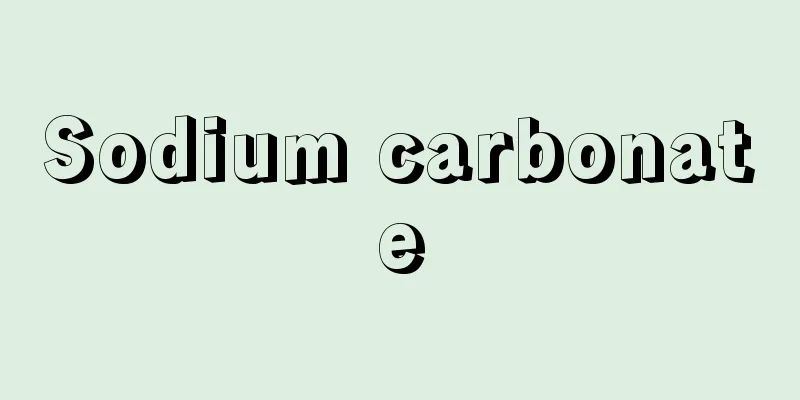Sodium carbonate

|
Sodium carbonate. It is commonly called sodium carbonate or simply soda. The anhydrous form is called soda ash (anhydrous sodium carbonate), and the decahydrate is called washing soda (crystalline soda). In nature, it exists as a monohydrate (thermonatrite) or decahydrate (natron). Crystals with the composition Na 2 CO 3 · NaHCO 3 · 2H 2 O are deposited around or on the bottom of salt lakes that contain a lot of sodium carbonate, i.e. soda lakes, and are called trona. Natural soda with this composition is produced in large quantities in America, Africa, Egypt, China, etc. It was the world's first soda, used in ancient Egypt to make glass and soap. Sodium carbonate is also found in the ash of burnt seaweed, and was once extracted from this. [Torii Yasuo] Manufacturing methodIndustrially, there are three methods: the ammonia soda process (Solvay process), the Leblanc process, and the electrolytic soda process, but currently in Japan, only the ammonia soda process is used. In this method, ammonia is absorbed into a saturated solution of salt, and then carbon dioxide is passed through. The precipitated sodium bicarbonate is burned to make sodium carbonate. To increase the utilization rate of sodium, a variation of this method, the ammonium chloride process, has been developed in Japan. In recent years, natural soda mining has become large-scale, and in the United States and other countries, more than 80% of production is done using this method. [Torii Yasuo] natureThe anhydrate is a white hygroscopic powder that dissolves well in water but poorly in alcohol. When crystals precipitate from an aqueous solution, they become the decahydrate at temperatures below 32°C, the heptahydrate at temperatures between 32-35°C, and the monohydrate at temperatures above 35°C. The monohydrate is a white deliquescent crystal. The decahydrate is an efflorescent crystal that loses water of crystallization in air to become the monohydrate. It dissolves in water of crystallization at 32°C. The aqueous solution hydrolyzes and becomes strongly alkaline. Na2CO3 + H2ONaHCO3 + NaOH [Torii Yasuo] ApplicationsSodium carbonate is one of the most important chemicals in the world, widely used as an alkali and source of sodium. It is used in the manufacture of glass, soap, pulp and paper, food, and chemicals, as well as in laundry detergents and medicines. [Torii Yasuo] [References] | | | | [Supplementary information] | |©Shogakukan "> Solubility curve of sodium carbonate and the water that precipitates... Source: Shogakukan Encyclopedia Nipponica About Encyclopedia Nipponica Information | Legend |
|
炭酸のナトリウム塩。俗に炭酸ソーダまたは単にソーダといわれる。無水和物にはソーダ灰(無水炭酸ナトリウム)、十水和物には洗濯ソーダ(結晶ソーダ)の名がある。自然界には一水和物(サーモナトライト)、十水和物(ナトロン)として存在する。炭酸ナトリウムを多く含んだ塩湖すなわちソーダ湖の周辺や湖底にはNa2CO3・NaHCO3・2H2Oの組成の結晶となって堆積(たいせき)しておりトロナとよばれる。このような組成の天然ソーダはアメリカ、アフリカ、エジプト、中国などに多量に産出する。古代エジプトでガラスやせっけんなどの製造に用いられた世界最初のソーダである。炭酸ナトリウムは海藻を焼いた灰の中にも含まれ、昔はこれから抽出されていた。 [鳥居泰男] 製法工業的にはアンモニアソーダ法(ソルベー法)、ルブラン法、電解ソーダ法の三つの方法があるが、現在日本ではアンモニアソーダ法以外はほとんど行われていない。この方法では食塩の飽和溶液にアンモニアを吸収させたのち、二酸化炭素を通ずる。析出してきた炭酸水素ナトリウムを焼いて炭酸ナトリウムとする。ナトリウムの利用率を高めるため、日本ではこの方法の変形として塩安ソーダ法が開発されている。 なお、近年天然ソーダの採掘が大規模に行われるようになり、アメリカなどでは生産量の80%以上がこの方法によっている。 [鳥居泰男] 性質無水和物は白色吸湿性の粉末で、水によく溶けるがアルコールには溶けにくい。水溶液から結晶が析出する場合、32℃以下では十水和物、32~35℃では七水和物、35℃以上では一水和物となる。一水和物は白色潮解性の結晶。十水和物は風解性の結晶で、空気中で結晶水を失って一水和物となる。32℃で結晶水の中に溶ける。水溶液は加水分解して強いアルカリ性を示す。 Na2CO3+H2ONaHCO3+NaOH [鳥居泰男] 用途炭酸ナトリウムはアルカリとして、またナトリウム源として広く利用され化学工業上もっとも重要なものの一つである。ガラスの原料となるほか、せっけん、紙パルプ、食品、化学薬品の製造に用いられる。また、洗濯用洗剤、医薬品としての用途もある。 [鳥居泰男] [参照項目] | | | | [補完資料] | |©Shogakukan"> 炭酸ナトリウムの溶解度曲線と析出する水… 出典 小学館 日本大百科全書(ニッポニカ)日本大百科全書(ニッポニカ)について 情報 | 凡例 |
Recommend
"The reputation of the Iozaki insect" - The reputation of the Iozaki insect
…This work takes the reputation of pleasure quart...
Desk - Desk
It is a trapezoidal piece of furniture for doing ...
Hamari Julia
1942- Hungarian alto singer. Graduated from the Ac...
Pilotis (English: pilotis, French)
Originally a French word meaning a pile supportin...
Shankar
Indian sitar player and composer. He started out a...
Turumagi (English spelling)
The name of the outer garment worn as an outerwear...
Dry laundry - Dry laundry
Dry cleaning is a method of removing dirt from clo...
Curculio
...A general term for insects of the genus Curcul...
Trombiculidae
…General term for mites belonging to the suborder...
Protectionist Party
The direct origin of the party dates back to 1834...
Smoke tree
A deciduous shrub or small tree of the Anacardiace...
Jizobon - Jizobon
〘Noun〙 An event held in Kyoto from August 22nd to ...
Hermopolis
In ancient Egypt, it was called the City of Horus...
Sidereal time
A sidereal day is the time from when the vernal e...
Osaka Conference
The conference was held in Osaka in January and F...









